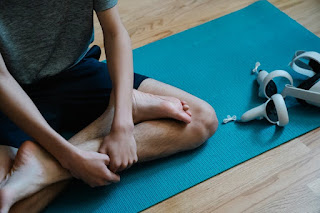Guided Meditation for Stress: Anxiety and Stress Relief | Nivati
Mindfulness Meditation: A simple, fast way to reduce stress
In the whirlwind of daily responsibilities and challenges, stress can accumulate rapidly, often without us even noticing until it manifests physically or emotionally. However, integrating meditation into your routine can be a surprisingly simple and quick remedy for this modern malaise. From advanced meditation to beginner meditations incorporating specific techniques to manage stress into your regular practice sessions brings transformation and relief from the daily stresses we all experience.
Meditation has long been revered as a potent tool for calming the mind and soothing the nervous system. It doesn’t require special equipment or extensive training; a few minutes can be enough to make a significant difference. Here’s how meditation provides a rapid response to stress:

Immediate Relaxation Response: Meditation triggers the body’s relaxation response, a state of restfulness that is the polar opposite of the stress response. When you meditate, your breathing slows, your blood pressure drops, stress reduction is achieved, and your stress hormones, particularly cortisol, decrease. This physiological change is both immediate and profound, helping to lower the levels of stress hormone associated with various health issues.
Enhanced Self-Awareness: Regular meditation increases your awareness of your thoughts and feelings. By becoming more aware, you can better recognize the onset of stress and address it before it overwhelms you. This self-awareness is a critical skill for managing stress in high-pressure environments.
Cognitive Reappraisal: Meditation teaches you to observe your thoughts without judgment. This practice helps in reassessing your reactions to stressful situations, often leading to a more balanced perspective. Instead of being swept away by stress, you learn to view challenges with clarity and poise.
Accessible Anytime, Anywhere: One of the greatest benefits of meditation is its flexibility. Whether you have a full hour or just five minutes, meditation can be adapted to fit into your schedule. It can be practiced in many settings, whether you’re at home, in the office, or even on public transport.
Building Resilience: Over time, meditation not only helps in managing immediate stress but also builds resilience against future stress. It strengthens neural pathways in the brain associated with calmness and emotional regulation, making you less reactive to stressful events as they occur.
For those new to meditation, here are a few tips to get started:
- Find a Quiet Space: Minimize distractions by finding a quiet corner where you can meditate undisturbed.
- Set a Time Limit: Start with short sessions, about 5 to 10 minutes, and gradually increase the duration as you become more comfortable.
- Focus on Your Breath: Pay attention to your breathing. This focus will help anchor your mind and keep it from wandering.
- Use Guided Meditations: If you find it difficult to maintain focus, try guided meditations that can help lead you through the process.
As you incorporate meditation into your daily life, you’ll notice a shift in how you handle stress. It’s not just about finding a moment of peace; it’s about transforming your approach to life’s challenges. Embrace meditation as your secret weapon against stress, and witness its benefits unfold in all aspects of your life

How does stress impact the body?
Stress is not just a mental or emotional issue—it has tangible, physical effects on our bodies. Understanding these impacts can help us recognize the seriousness of managing stress effectively and employing effective strategies like meditation for relief. Here’s a closer look at how stress can affect the body:
1. The Nervous System When you’re stressed, your body’s sympathetic nervous system triggers the “fight or flight” response, releasing stress hormones such as adrenaline and cortisol. This can lead to a rapid heartbeat, increased blood pressure, and a surge of energy. While this response can be beneficial in short bursts, prolonged stress can overtax this system, leading to exhaustion, a compromised immune response, and other health issues.
2. The Musculoskeletal System Stress often leads to muscle tension, which is the body’s way of guarding against injury and pain. Chronic stress causes the muscles in the body to be in a more or less constant state of guardedness. Over time, this can cause musculoskeletal conditions such as tension headaches, migraines, and chronic pain disorders.
3. The Respiratory System Stress can affect breathing patterns and exacerbate conditions like asthma and chronic obstructive pulmonary disease (COPD). During high stress, you may breathe harder and experience rapid breathing, which can be a problem if you have a breathing disorder.
4. The Cardiovascular System Acute stress causes an increase in heart rate and stronger contractions of the heart muscle. The stress hormones cause your blood vessels to constrict and divert more oxygen to your muscles, preparing them for a quick response. Over time, chronic stress can lead to inflammation in the cardiovascular system, a risk factor for heart attacks and strokes.
5. The Endocrine System Stress triggers the adrenal glands to release cortisol, which helps to replenish the body’s energy after the stress response but also leads to increased appetite and potentially weight gain. Chronic stress can also affect the thyroid and can alter your blood sugar levels, increasing the risk of developing type 2 diabetes.
6. The Gastrointestinal System Stress can affect every part of the digestive system, causing stomachaches, nausea, and changes in appetite. Long-term stress can exacerbate gastrointestinal diseases, including gastroesophageal reflux disease (GERD), peptic ulcer disease, and irritable bowel syndrome (IBS).
7. The Reproductive System Stress affects the reproductive system differently in men and women. In men, excessive stress can affect testosterone production and sperm production and motility. In women, stress can cause irregular menstrual cycles, reduced sexual desire, and complications during pregnancy.
Understanding these physiological effects underscores the importance of managing stress through methods like guided meditation, which not only helps mitigate the immediate feelings of stress but also aids in reducing the long-term health impacts associated with it.

Using Guided Meditation for Anxiety and Stress Relief
Guided meditation, particularly focused on stress relief meditation, is a particularly effective tool for managing anxiety and stress, tailored to lead individuals through relaxation techniques and mindfulness exercises. It employs a voice—either live or recorded—that gently guides you through a series of calming visualizations and breathing exercises designed to relax the mind and body. Here’s how guided meditation can specifically help alleviate anxiety and stress:
1. Structured Approach to Relaxation Guided meditation provides a structured approach to relaxation that can be especially helpful for beginners or those who find their mind wanders. The guidance keeps you focused and helps navigate your thoughts away from daily worries and stressors towards a state of calm.
2. Accessibility and Ease of Use One of the main benefits of guided meditation is its accessibility. There are numerous apps, websites, and audio recordings available, making it easy to practice anywhere and at any time. This convenience means that relief from stress and anxiety is only as far away as your smartphone or other digital devices.
3. Variety of Techniques Guided meditation can introduce you to a variety of meditation techniques, including mindfulness, progressive relaxation, focused attention, and mindful movement. This variety helps to keep the practice fresh and engaging, and allows individuals to find the method that works best for them, enhancing the stress-relief experience. Mindful movement, which combines physical activity with mindfulness to cultivate awareness and reduce stress, is particularly beneficial for those looking to integrate their body, heart, and mind.
4. Enhanced Focus on the Present By guiding you to focus on the present moment and fostering a greater awareness of your body and surroundings, guided meditations help distract from past anxieties and future uncertainties. This focus on the ‘now’ is a fundamental principle of mindfulness that has been shown to significantly reduce stress levels.
5. Emotional Regulation and Resilience Regular practice of guided meditation enhances emotional regulation, teaching you to stay more balanced and less overwhelmed in stressful situations. Over time, this practice builds emotional resilience, equipping you to handle life’s stresses more effectively and with greater calm.
6. Improvement in Physical Health Guided meditation also offers direct physical health benefits, such as lowering blood pressure, reducing heart rate, and improving sleep patterns. These improvements can further reduce feelings of anxiety and stress, creating a positive feedback loop of overall health.
7. Support and Community Often, guided meditations are conducted in group settings, either in person or online, providing a sense of community and support. Sharing the experience with others can enhance the stress-relieving effects and offer additional encouragement and motivation.
For those looking to start guided meditation, here are a few tips:
- Choose a Quiet Environment: While guided meditations can be done anywhere, starting in a quiet, comfortable space can enhance your focus and relaxation.
- Select Appropriate Guided Sessions: Look for sessions that specifically address anxiety and stress relief to get the most targeted benefits.
- Consistency is Key: Regular practice increases the effectiveness of meditation, so try to incorporate it into your daily routine.
Guided meditation is a versatile and powerful tool for managing anxiety and stress, providing not just temporary relief but also long-term improvements in mental health and physical well-being.

4 Ways to Calm Your Mind in Stressful situations
Stressful situations are inevitable, but how we respond to them can make a significant difference in our overall well-being. Incorporating just a few moments of these strategies into your daily routine can provide relief quickly and efficiently, making them highly accessible for everyone. Here are four effective strategies to calm your mind when you find yourself in high-pressure scenarios, leveraging both meditation techniques and practical psychological tools.
1. Deep Breathing Exercises One of the quickest and most effective ways to calm the nervous system is through deep breathing. The practice of taking slow, deliberate breaths can help reduce tension and bring about a sense of calm almost immediately. Techniques such as the 4-7-8 breathing method, where you inhale for four seconds, hold your breath for seven seconds, and exhale for eight seconds, can be particularly effective in mitigating acute stress.
2. Progressive Muscle Relaxation (PMR) PMR is a technique where you tense and then relax different muscle groups in the body. This process not only helps relieve the physical tension that stress can bring but also promotes a mental awareness of relaxation. Start from the toes and work your way up to the top of your head, tensing each muscle group for a few seconds before releasing it. This method is especially useful before bed to alleviate stress and improve sleep quality.
3. Visualization Visualization, or guided imagery, involves imagining a scene in which you feel at peace, free from stress and anxiety. This could be a quiet beach, a serene forest, or any place that helps you feel relaxed. The key is to engage all your senses in this visualization—consider what you see, hear, smell, and feel within this calming place. This mental escape can provide a temporary refuge from the stressors at hand.
4. Mindful Observation This mindfulness exercise involves focusing all your attention on a single point of reference. It could be anything in your environment—a flower, the sound of rain, a piece of artwork, or even a complex object like a clock. Observing every detail about the object allows your mind to focus on the present moment and detach from worries about the past or future, effectively reducing stress.

Choose A De-Stress Meditation Type That Works For You
Finding the right type of meditation to effectively manage stress is a personal journey. Each person responds differently to various meditation techniques, so it’s essential to explore a few options to discover what works best for you. Mindfulness practice is a foundational aspect of many meditation types, emphasizing the importance of incorporating it into your daily routine for holistic stress management. Below are some popular types of de-stress meditation practices that can help you maintain calm and achieve inner peace.
1. Mindfulness Meditation Mindfulness meditation encourages you to observe wandering thoughts as they drift through your mind. The intent is not to get involved with the thoughts or to judge them, but simply to be aware of each mental note as it arises. This practice helps you achieve a state of calm by focusing on being intensely aware of what you’re sensing and feeling in the moment, without interpretation or judgment. It can be particularly effective for those who find themselves overwhelmed by stressors because it trains you to stay present and engaged.
2. Body Scan Meditation This form of meditation involves mentally scanning your body for areas of tension and consciously releasing it. Starting from the toes and moving upwards, you’ll focus on each specific body part. This technique not only helps release physical tension but also brings awareness to areas where you hold stress, helping to manage and mitigate it over time.
3. Guided Visualization Guided visualization, or guided imagery, involves visualizing a place where you feel completely relaxed. This technique is typically guided by a recording or instructor and can be particularly useful for those who respond well to visual cues. The scenes are often accompanied by calming music or sounds from nature, enhancing the relaxation experience.
4. Mantra Meditation In mantra meditation, you silently repeat a calming word, thought, or phrase to prevent distracting thoughts. This type of meditation is useful for those who might need a bit more structure in their meditation practice or those who find silence and stillness challenging. The repetition of the mantra can help focus the mind and ease the body into a state of relaxation.
5. Movement Meditation Although most forms of meditation are performed while sitting still, movement meditation involves moving the body. Techniques such as yoga, tai chi, and qigong combine fluid movements with controlled breathing and mental focus. This form of meditation is ideal for those who find peace through action and prefer to let their minds wander through motions that align breathing and movement.
Experimentation is Key Experimenting with different types of meditation can help you understand your preferences and what best suits your lifestyle and stress management needs. Practice meditation regularly as a way to find what works best for you, as many people find that a combination of several forms works best. Remember, the goal of meditation is to bring peace and calm to your mind and body, so choose the type that feels most natural and effective for you.

A 2-Minute S.T.O.P. Practice to Ease a Worried Mind
In the midst of a busy day or during a moment of high stress, finding a quick way to regain balance and clarity is crucial. The S.T.O.P. practice is a mindfulness technique that can be done in just two minutes to help interrupt the cycle of stress and anxiety. S.T.O.P. stands for Stop, Take a breath, Observe, and Proceed. Here’s how you can implement this practice:
Stop: As soon as you notice your mind is reacting to stress, pause whatever you are doing. This step is the foundation of the practice, as it helps you halt the automatic stress response and gives you a moment to step back.
Take a Breath: Take a deep, slow breath in, and then exhale slowly. Focus entirely on the sensation of breathing. This helps to center your mind and uses your breath as an anchor to the present moment, reducing immediate feelings of anxiety.
Observe: Pay close attention to what’s happening inside you. Observe your thoughts, feelings, and physical sensations without judgment. This observation allows you to recognize what is troubling you and gives you a clearer picture of what is actually going on, as opposed to what you might initially perceive.
Proceed: Once you’ve taken a moment to breathe and observe, make a conscious decision about how to proceed. Choose an action that will help you address whatever stress or anxiety you’re experiencing in a healthy and productive way. This might involve changing what you are doing, adjusting your expectations, asking for help, or simply accepting what is.
This S.T.O.P. practice can be particularly effective because it’s short, simple, and can be done anywhere at any time. Whether you’re in the middle of a hectic day at work or feeling overwhelmed at home, taking just two minutes to perform this mindfulness exercise can help you manage stress and reduce anxiety effectively.
By integrating the S.T.O.P. practice into your daily routine, especially during times of high stress, you can develop a powerful habit that enhances your ability to stay calm, focused, and in control under pressure.





